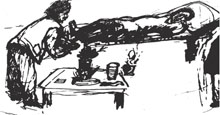3.2 Abortion
Give the correct definition of abortion. (Remember you studied this in Study Session 20 of the Antenatal Care, Part 2 Module.)
Abortion is the termination or ending of a pregnancy before fetal viability, which is conventionally taken to be less than 28 weeks from the last normal menstrual period. It can happen on its own (spontaneous abortion or miscarriage), or it can be caused deliberately (induced). Abortion may be induced by medical procedure legally, or it may be an unsafe non-medical intervention, which is illegal.
The conditions under which abortion is legal in Ethiopia are indicated in Section 3.2.2
In many countries, 30–60% of pregnancies among adolescents end in abortion. Studies show that almost 6 in 10 abortions in Ethiopia are unsafe. Women seeking induced abortion in 2008 in Ethiopia had a mean age of 23, the majority (54%) being single. Seeking care after a second-trimester abortion was more common among women who lived in rural areas than among their urban counterparts. According to another study, by the Ethiopian Society of Obstetricians and Gynecologists (ESOG) in the year 2000, three-quarters of patients had spontaneous abortions and one-quarter of them had an induced abortion. However, this figure may not be accurate as women who have an induced abortion do not always tell the truth because of fear and uncertainty of the reaction of other people.
Adolescents and young people are more likely to have an unsafe abortion, which is the termination or ending of a pregnancy by an unskilled, non-medical provider (Figure 3.2). It may be that a safe service is not accessible, affordable, or permitted by law. This might cause adolescents to try to self-induce an abortion or have the procedure carried out by an unskilled provider. Because of economic problems and/or other reasons, adolescent and young women are also more likely to postpone abortion until after the first trimester, which makes the procedure more risky.

A study in Addis Ababa in 2001 showed that 28% of abortions were self-induced, while 35% were performed by health assistants and only 9% by medical doctors. Materials used to induce an abortion included plastic catheters (14% of surveyed women), plastic tubes (32%), ampicillin (32%), metallic rods (22%), and roots or herbs (5%). As these figures are from one study, variation is to be expected from region to region and between urban and rural areas.
3.1.3 The consequences of unwanted pregnancy
